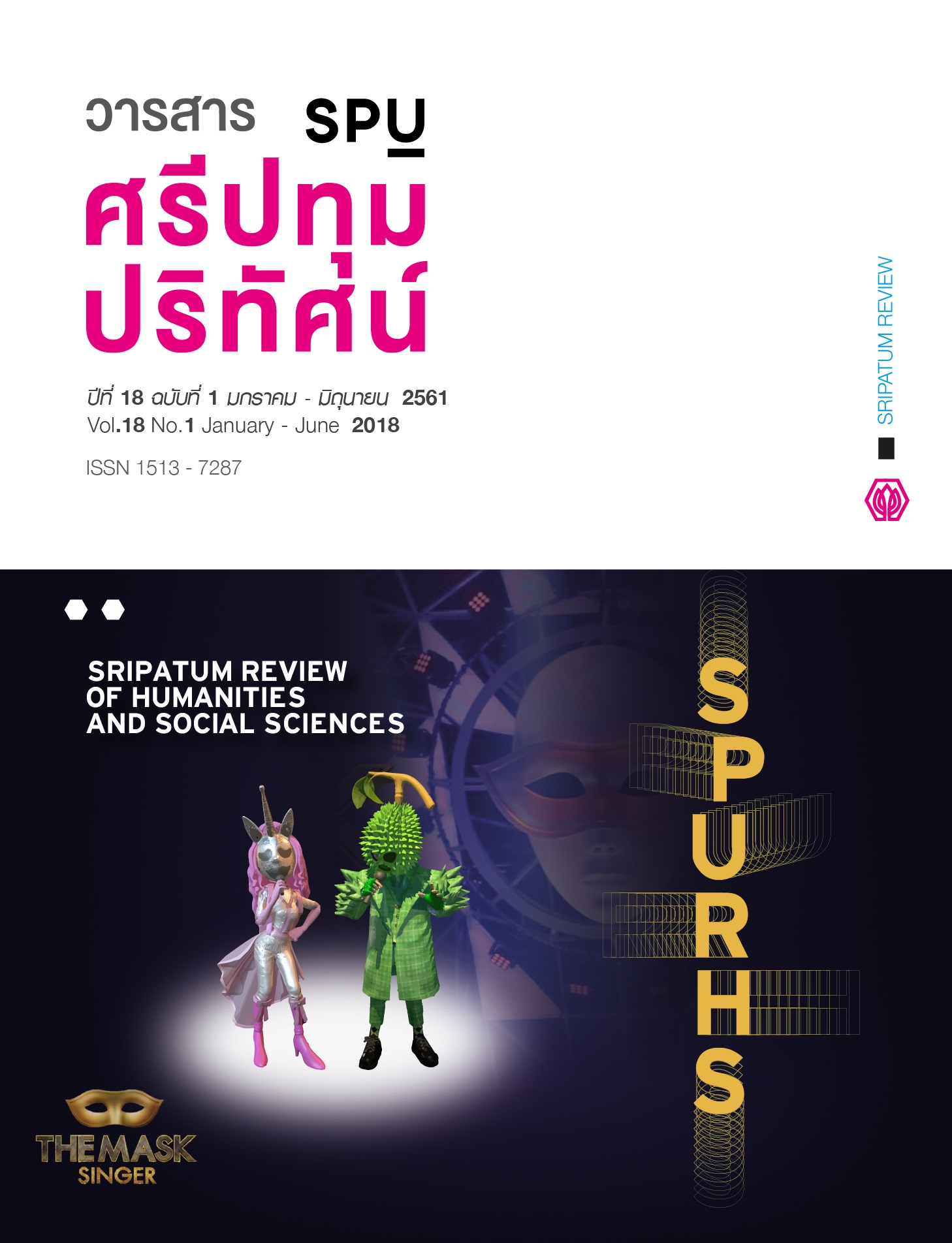การจำลองข้อมูลด้วยวิธีมอนติคาร์โลโดยใช้ LISREL สำหรับการวิเคราะห์โมเดลสมการโครงสร้างแบบไม่เป็นเส้นตรง
Main Article Content
บทคัดย่อ
โมเดลสมการโครงสร้างนำมาใช้ในงานวิจัยพฤติกรรมและสังคมศาสตร์กันอย่างแพร่หลายทั้งที่เป็นโมเดลสมการโครงสร้างแบบเป็นเส้นตรงและโมเดลสมการโครงสร้างแบบไม่เป็นเส้นตรง ซึ่งโมเดลสมการโครงสร้างแบบไม่เป็นเส้นตรงนำมาใช้ในช่วงไม่กี่ทศวรรษที่ผ่านมาในงานวิจัยต่างประเทศ การจำลองข้อมูลด้วยวิธีมอนติคาร์โลในการวิเคราะห์โมเดลสมการโครงสร้างแบบไม่เป็นเส้นตรงมีหลายวิธีภายใต้เงื่อนไขแตกต่างกันออกไป ในการวิเคราะห์มีขั้นตอนหลักดังนี้ 1) การสร้างโมเดลและกำหนดพารามิเตอร์ที่นักวิจัยสนใจที่จะศึกษา 2) การจำลองข้อมูลเพื่อให้ได้ชุดของข้อมูลสำหรับนำไปวิเคราะห์ และ 3) คำนวณพารามิเตอร์ด้วยสถิติต่างๆ การจำลองข้อมูลด้วยวิธีมอนติคาร์โลมีประโยชน์สำหรับการประมาณค่าพารามิเตอร์ในโมเดลที่มีซับซ้อน ข้อมูลที่มีจำนวนมาก และโมเดลแบบไม่เป็นเส้นตรงมีการพัฒนาคำสั่งเฉพาะในหลายโปรแกรม เช่น Mplus,LISREL, Visual-PLS, R software package เป็นต้น ซึ่งในบทความนี้นำเสนอรายละเอียดเฉพาะวิธีการจำลองข้อมูลด้วยวิธีมอนติคาร์โลในการวิเคราะห์โมเดลสมการโครงสร้างแบบไม่เป็นเส้นตรงโดยใช้โปรแกรม LISREL แม้ว่าเป็นวิธีการวิเคราะห์ที่ยากและซับซ้อน แต่ไม่ใช่เหตุผลที่จะนำไปสู่การจำกัดการพัฒนาองค์ความรู้โดยจะนำเสนอเพื่อให้มีการนำมาใช้ให้แพร่หลายและเป็นการขยายองค์ความรู้ให้กว้างขวางมากขึ้น
Article Details
1. กองบรรณาธิการสงวนสิทธิ์ในการพิจารณาและตัดสินการตีพิมพ์บทความในวารสาร
2. บทความทุกเรื่องจะได้รับการตรวจสอบทางวิชาการโดยผู้ทรงคุณวุฒิ แต่ข้อความและเนื้อหาในบทความที่ตีพิมพ์เป็นความรับผิดชอบของผู้เขียนแต่เพียงผู้เดียว มิใช่ความคิดเห็นและความรับผิดชอบของมหาวิทยาลัยศรีปทุม
3.การคัดลอกอ้างอิงต้องดำเนินการตามการปฏิบัติในหมู่นักวิชาการโดยทั่วไป และสอดคล้องกับกฎหมายที่เกี่ยวข้อง
References
เสน่ห์ พลีจันทร์, พูลพงศ์ สุขสว่าง และสุพิมพ์ ศรีพันธ์วรสกุล. 2555. “โมเดลความสัมพันธ์เชิงสาเหตุของพฤติกรรมการป้องกันโรคอุจาระร่วงรุนแรงจากเชื้ออีโคไล โดยมีการรับรู้ความสามารถในการควบคุมตนเองเป็นตัวแปรกำกับ.” วิทยาการวิจัยและวิทยาการปัญญา, 10(2), 35-44.
Abd-Elmotaleb, M., & Saha, S. K. 2013. “The role of academic self-efficacy as a mediator variable between perceived academic climate and academic performance.” Journal of Education and Learning, 2(3), 117-129.
Barendse, M. T., Oort, F. J., & Garst, G. J. A. 2010. “Using restricted factor analysis with latent moderated structures to detect uniform and nonuniform measurement bias: a simulation study.”Advances in statistical analysis, 94, 117–127.
Chin, W. W., Marcolin, B. L., &Newsted, P. R. 2003. “A partial least squares latent variable modeling approach for measuring interaction effects: results from a Monte Carlo simulation study and an electronic-mail emotion/adoption study.”Information system research, 14(2), 189–217.
Falahati, L. & Sabri, M.F. 2015. “An Exploratory Study of Personal Financial Wellbeing Determinants: Examining the Moderating Effect of Gender.”Asian Social Science, 11(4). 33 – 42.
Goodhue, D., Lewis, W., & Thompson, R. 2007. “Statistical power in analyzing interaction effects: questioning the advantage of PLS with product indicators.”Information system research, 18, 211–227.
Kelava, A., & Brandt, H. 2009. “Estimation of nonlinear latent structural equation models using the extended unconstrained approach.”Review of psychology, 16(2), 123-131.
Klein, A. G., & Muthén, B. O. 2007. “Quasi maximum likelihood estimation of structural equation models with multiple interaction and quadratic effects.”Multivariate behavioral research, 42, 647–673.
Kroese, D.P., Brereton, T., Taimre, T., &Botev, Z.I. 2014. “Why the Monte Carlo Method is so important today.”WIREs comput stat, 6, 386-392,Doi: 10.1002/wics.1314
Moosbrugger, H., Schermelleh-Engel, K., Kelava, A., & Klein, A. G. 2009. “Testing multiple nonlinear effects in structural equation modeling: a comparison of alternative estimation approaches.” NL: Sense Publishers.
Marsh, H. W., Wen, Z., & Hau, K. T. 2004. “Structural Equation Models of Latent Interactions: Evaluation of Alternative Estimation Strategies and Indicator onstruction.”Psychological methods, 9(3), 275-300.
Muthén, L. K., & Muthén, B. O. 2010. “Mplus user’s guide (6th ed.).”LA: Muthén & Muthén.Schermelleh-Engel, K., Kerwer, M., & Klein, A. G. 2014. “Evaluation of model fit in nonlinear multilevel structural equation modeling. Frontiers in psychology, 5(181), 1-11.
Schermelleh-Engel, K., Werner, C. S, Klein, A. G., & Moosbrugger, H. 2010. “Nonlinear structural equation modeling: Is partial least squares an alternative?.”Advances in statistical analysis, 94, 167–184.

